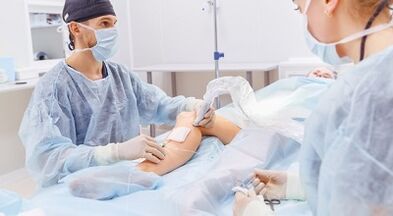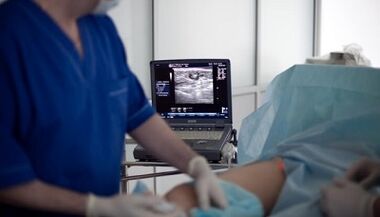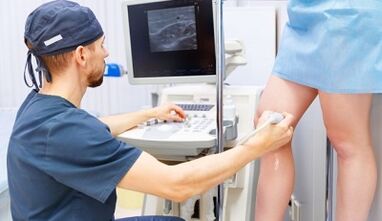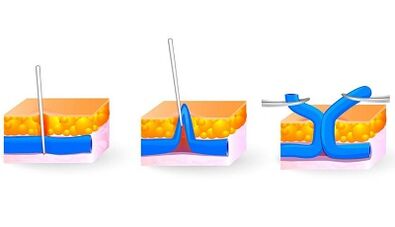
For many decades, the surgical treatment of the varicose veins of the legs remains the only radical method to eliminate this disease and its complications.
Thanks to modern technologies and the improvement of operating techniques, it is really effective both in therapeutic and cosmetic terms, it is carried out in the easiest and painless pain possible, well tolerated by patients and does not cause prolonged disability.
Indications and contraindications
It is not advisable to operate patients with any varicose veins.There are clear indications for the operation and contraindications for its implementation.
The surgical treatment of the varicose veins of the lower extremities is indicated in the following cases.
Medical indications- A pronounced expansion of 2-3 degree veins, accompanied by complaints and signs of chronic venous failure:
- convincing and tense veins under the skin;
- multiple varics (nodes) along the changed vessels;
- swelling of the affected leg;
- Severity and pain along the expanded vein;
- seizures in the calf muscles at the bottom of the leg, when "reduces the leg;
- Inflammatory changes in the veins: thrombophlebitis;
- Trophilic skin disorders Dark spots, redness, sealed from the subcutaneous layer, a long leave wound.
Cosmetic indications- Early (first) stage of the varicose veins without signs of venous insufficiency, causing only a cosmetic defect and aesthetic discomfort in the patient:
- located superficially slightly expanded and convoluted veins;
- "Vascular stars," spider "and small blue capillaries in the skin of the legs.
It is important to remember that even if there are indications of the operation, one has to reject if the risk of exceeding it.
The main contraindications for the surgical treatment of varicose veins:
- The general serious condition caused by any acute (heart attack, stroke, pneumonia) launched chronic diseases (liver, cordial, pulmonary failure) or patient's old age.
- Any acute infectious disease.
- Conductive treatment for cancer.
- Pronounced anemia.
- An increase or decrease pronounced in blood clotting.
- Inflammatory and suppurative processes (scores, rashes) in the skin of the lower limb, where surgical intervention is planned.
- Pregnancy and early postpartum period.
All contraindications, except the first, are considered relative.This means that in special circumstances (acute dangerous conditions caused by varicose veins, for example, thrombophlebitis in the thigh), one or another volume of surgical treatment should be performed.
When an emergency operation is needed
Emergency surgical treatment of the varicose veins of the legs may be required in a single case, with acute ascending thrombophlebitis.This complication is an inflammation within the light of a large subcutaneous vein, accompanied by the formation of blood clots.

If this pathological process applies to the thigh, there is the risk of grabbing blood clots in a deep venous system.In case of separation of said blood clot, penetrates the vessels of the lungs and obstructs them, which causes a threatening life of a dangerous disease: pulmonary thromboembolism (pulmonary fiber).
The main manifestations of thrombophlebitis in the ascent thigh:
- pain along the vein along the internal surface of the thigh;
- redness and increase in skin temperature;
- The seal of the changed area and its acute pain in the palpation.
With ascending thrombophlebitis, the volume of surgical treatment can be represented:
- Crossectomy: dressing and intersection of a large subcutaneous vein in the place of confluence with the bed;
- Elimination of a changed vein after preliminary dressing.
The objectives of surgical intervention
Normally, approximately 30% of the blood of the lower extremities flows through small subcutaneous venous tributaries, which are merged into two central venous trunks: a large and small subcutaneous veins.These vessels are directly connected to deep veins, through which 70% of the blood flows.In the places of such compounds there are valves that pass blood only from the superficial to the deep veins.
There are also dozens of small veins, which are called perforators, which also connect the venous network of the surface with depth.They also have valves that pass blood in one direction.
The main cause of the varicose veins is the failure of the venous valves, which leads to an inadequate blood discharge: from deep veins to the surface, which increases the pressure in them and leads to the expansion of small vessels and central venous trunks.
The main objectives for which surgical treatment is aimed at the varicose veins of the lower extremities:
- The elimination of the stagnation of the blood in the altered surface veins of the legs, which will prevent the progression of chronic venous insufficiency and trophic disorders in the skin.
- Eliminate deformed vessels and varieties that represent a cosmetic defect.
- The elimination of the blood discharge from the deep veins to the superficial: the ligation and the intersection of the perforating veins (clans), as well as the large and small subcutaneous veins in the places of their connection with the deep ones.
- Prevention of a repeated occurrence of varicose veins.
Preparation for operation
The complete preparation for surgical treatment for varicose veins includes:
- A general preoperative exam that allows you to evaluate the patient's healthy blood and urine tests, coagulogram, biochemical analysis, blood type and HR factor, syphilis tests, blood sugar level, pulmonary radiography, ECG.
- Special diagnoses that allow it to determine the characteristics of the disease: an ultrasound with surface Doppler color mapping, deep veins and arteries of the lower extremities and designating the location of the insolvent drilling veins.
- The operation is performed with an empty stomach, so on the morning of the day of the operation you cannot eat and drink.
- In the morning before the operation, it is necessary to carefully shave all the hair of the painful leg from the groin to the foot.
Treatment of female varicose veins

A separate place in the surgical treatment of the female varicose veins of the lower extremities belongs to cosmetic surgery.After such interventions, not only the pathologically altered veins, but also postoperative scars on the skin of the legs, or are discreet.
To achieve maximum cosmetic effect, surgical surgery for varicose veins is carried out according to the following methods:
- Laser or radiofrequency ablation veins-Burning the central trunks of a large and small subcutaneous vein under ultrasound control through a puncture of the skin in the thigh or foot.
- Sclerobliteration and sclerotherapy-They large and small subcutaneous veins, as well as all its tributaries, even the smallest, with a special sclerot drug.
With any of the treatment methods described, the varicose veins are not eliminated, but become the blood vessels into a soft scar tissue.Both physical influences (laser rays, radiofrequency waves) and chemical compounds (sclerosantes) destroy the inner layer of the vein.Thanks to this, it loses the light, the sticks and is completely disolished from the blood, becoming an ordinary connective tissue (scar).
Therefore, without the direct elimination of the veins, all the objectives assigned to the rapid treatment of the varicose veins of the lower extremities are achieved: the changed vessels are eliminated and the dangerous consequences of venous insufficiency in them are eliminated.
The only restriction of cosmetic operations in the treatment of varicose veins in women is possible only expanded veins slightly or limited to 1-2 degrees.During pregnancy and in the early postpartum period, surgical treatment is contraindicated with the exception of acute situations that require emergency intervention, for example, with ascending thrombophlebitis.The operation is limited to the dressing of a large subcutaneous vein in the place of its connection with the femoral (Crossectomy).
Types of surgical operations
Consider the most common surgical interventions in the treatment of varicose veins of the lower extremities: laser ablation, endoscopic dissection of veins and phlebectomy.
The latter is divided into the following types:
- Classical operation, or complete bankruptcy or Operation of Trojanov Trendelenburg-Bubko-Narata;
- short peeled;
- Miniflebectomy.
Flebectomy
The extraction, the extraction of veins from under the skin is called phlebectomy.This is one of the first methods of surgical treatment of the varicose veins of the lower extremities.But even today, phlebectomy is performed more frequently by phlegology and vascular surgeons.There are three modifications and operating methods: complete, short dispossession, miniflebectomy.
The intervention volume is presented:
- As a bandage of the trunk of a large subcutaneous vein at the place of its confluence, 2-3 cm in the thigh under the inguinal fold, in the thigh, through an incision.
- Its elimination throughout the groin to the foot using a special probe through two cuts of the skin 1-2 cm along the internal surface near the knee and ankle.
- The elimination of all varicose veins and small veins through small separate incisions is approximately 1-2 cm (they can be 5-6 to 10-20) with the dress of insolvent perforating vessels.
- Sew all wounds with cosmetic seams.
Classical phlebectomy allows you to eliminate varicose veins, but the most traumatic among all existing techniques.
Shorting
With a short strip, the entire large subcutaneous vein is not eliminated, but only its fragments, affected by varicose veins, for example, only in the thigh or at the bottom of the leg.Healthy segments are not eliminated.This reduces the trauma of the intervention, but the risk of relapse of the disease remains.Otherwise, the operational operations of the operation are similar to classical phlebectomy.
Miniflebectomy

The innovative methodology to eliminate small varicose veins of a large subcutaneous vein is called miniflebectomy.
For its implementation, special tools are needed (scoring scalpel, hooks, clamps, spatula), with which the veins are extracted through the skin of the skin several millimeters.It is not necessary to sew such skin defects, the scars are invisible.
Most of the time, surgeons combine a short or complete elimination of a large subcutaneous vein with miniflebectomy.Such combined operation combines radicalism and minimal trauma with a good cosmetic effect.
Endoscopic dissection of veins
Finding all lower perforated veins during any phlebectomy is difficult.For these purposes, endoscopic equipment (video camera and manipulators) is used.Through small cuts in 1-2 cm, they are inserted under the skin in places of groups of perforating veins, which are detected with ultrasound.
Under camera control, all lower perforators find them, sell them and cross them.During this operation, subcutaneous veins are not eliminated.It can be performed both independently and in combination with any type of phlebectomy: elimination, miniflebectomy.
Laser treatment
Laser ablation for varicose veins implies burning with a laser beam of a large subcutaneous vein from the side of its free space.To do this, through the puncture of the skin in the thigh or in the ankle area in the vein light, a catheter-manager is introduced in its entire length.Under ultrasound control, the Svetovod is slowly extracted.
The laser beam, which acts on the venous wall, destroys the inner layer.As a result, Vienna falls and stops working, which is clearly visible in the ultrasound monitor.If not only the main venous trunk, but also its tributaries, are eliminated by varicose veins, they are eliminated according to the miniflebectomy method.
Rehabilitation
Regardless of the operational methods of treating varicose veins, the restoration of patients in the postoperative period occurs rapidly.The terms of complete rehabilitation depend on the surgery methodology, the stage of the disease and the general condition of the patient.With laser treatment and miniflebectomy of the initial varicose veins, it is 2-3 weeks, with classical phlebectomy for advanced diseases of the disease-1-3 months.
It is recommended to walk as soon as possible, provided that the condition is stabilized after anesthesia, after 5-6 hours.If spinal anesthesia was performed, bed rest is recommended within 12 hours.With local anesthesia, the patient can leave the standing room and is not even hospitalized in a hospital.The main condition before walking is to bandage the legs with an elastic bandage or put a compression knitted garments individually selected.
Stay at the hospital from 1-2 to 5-8 days.If the seams overlap, it is better to eliminate them in 7-8 days during a specialist control inspection.Within a month after surgery, it is recommended to wear compression knit garments.It is necessary to put it daily before getting out of bed.At night, compression products are eliminated.After classical phlebectomy with severe varicose veins, it is better to continue compression for up to 3 months.
Throughout the month, it is strictly prohibited:
- sauna and hot bath;
- heavy physical activity in the lower extremities;
- A long stay in a still or sitting position.
Possible complications
The most common complications related to operations for varicose veins:
- Leg pain operated as a result of large nerve damage.
- Long swelling of the leg and foot.
- Bruises and bruises at the bottom of the leg and thigh.
- Bleeding wounds.
- Flobotrombosis - Inflammation of deep veins.
- Supervision of postoperative wounds and necrosis (mortality) of the skin around it with the formation of trophic ulcers.
- The formation of gross postoperative scars.
Thanks to modern methods and technologies, surgical treatment of varicose veins is easy, painless and high efficiency.The fulfillment of all the recommendations of the postoperative period contributes to the rapid restoration, minimizes the risk of complications and relapses of the disease.























